Characterisation of End-of-Life Wind Turbine Blade Components for Structural Repurposing: Experimental and Analytic Prediction Approach
Abstract
1. Introduction
1.1. Objectives (Os)
1.2. Research Questions (RQs)
- How can the mechanical condition of the EoL WTB spar cap be assessed, and which established methods are suitable for evaluating their mechanical properties and their potential for structural repurposing in the construction sector (RQ1)?
- How do the as-received mechanical properties of EoL WTB spar caps vary across different WTB models, and which practically accessible parameters can be quantified to describe this variability (RQ2)?
- How can a parameter-driven prediction tool reduce the need for extensive and expensive experimental testing while enabling the practical and reliable assessment of as-received spar cap properties (RQ3)?
2. Materials and Methods
2.1. EoL GFRP Spar Cap Materials from Different WTB Models
- An EoL WTB from an E40/5 WT with an output of 500 kW, which was in use for approximately 20 years in the North of Germany (Emden), referred to as E40/5 WTB with a length of 19.3 m. The spar cap material from one location (1) of this WTB is analysed (Figure 2a).
- An EoL WTB from an E40/6 WT, built in April 2002 but never commissioned, referred to as the E40/6 WTB with a length of 21 m. The reasons for non-operation are not disclosed to the authors. A complete WTB is available for investigation, and three locations (1, 2, 3) are defined for the extraction of spar cap material (Figure 2b). The E40/6 WTB represents a design evolution of the E40/5 WTB.
- An EoL WTB from an E66 WT, referred to as E66 WTB, with a length of 33 m. It is sourced from a WT formerly located in Ihlow, Germany, and provided by an EoL WTB segment management facility. Neither the operator nor the facility specified the WTB’s service life. The spar cap material coming from one location (1) of the E66 WTB is analysed (Figure 2c).
2.2. Categorising R-Strategies for the GFRP Spar Cap Material Stream
2.3. Characterising As-Received Spar Cap Properties for R-Strategy Assignment
2.3.1. Sectioning for Recovering Spar Cap Specimens from EoL WTB
2.3.2. Material Characterisation of E40/5, E40/6 and E66 Spar Caps
- Optical microscopy:
- Calcination:
- Tensile tests:
- Differential scanning calorimetry:
- Bending tests at spar cap beam component
2.4. Prediction Tool for As-Received Spar Cap Properties
- The composite consists of matrix and fibre materials with isotropic linear-elastic mechanical properties. The material properties of the matrix (epoxy resin, with a Young’s modulus of = 3.78 GPa) and the glass fibre (with a Young’s modulus of = 73 GPa) were obtained [40].
- There is a perfect bonding between the fibres and matrix material.
- All fibres in the UD area are perfectly oriented in LD without any misalignment.
- The fibre volume fraction has a constant value in the UD area.
3. Results
3.1. Material Characterisation Results of E40/5, E40/6 and E66 Spar Caps
3.1.1. Microscopic Analysis
3.1.2. Calcination
3.1.3. Tensile Tests
3.1.4. Mechanical Characterisation of Spar Caps: A Comparison with Literature Data
- Composite architecture and spar cap thickness: The substantial differences between the outer region () and inner region thicknesses () of the epoxy and multiaxial layers can result in geometric asymmetry. This asymmetry can lead to uneven load distribution, reducing, e.g., stiffness during bending loads. The overall thickness , width , and of the spar cap beam can be measured using basic equipment, since the UD region can be visually distinguished from the non-UD region.
- Fibre volume fraction : It is observed from Table 4 that longer WTBs exhibit a higher in the UD region of the spar cap, resulting in an increased strength and modulus in LD. The parameter can be determined by correlating the length of the WTB, as derived from the rotor diameter of the WT in the MaStR. The suggested range of is 36% and 56% for WTB lengths from 9.8 m to 37 m. In scenarios where a low uncertainty in the predicted properties is required, the value of can be determined through experimentation (e.g., calcination), thereby reducing prediction uncertainty.
- Production quality: Unoptimised production quality is shown by a large number of defects in the spar cap material, which leads to reduced strain at failure, lower ultimate tensile strength and higher variance in .
- Load history: No link was identified between service life and material properties. Nonetheless, severely damaged spar cap components should be identified by NDT and excluded from the repurposing streams.
- Matrix type: The matrix of spar cap beams could influence the mechanical properties. Matrix materials that are sensitive to elevated temperatures may undergo degradation in properties, which have to be considered in the design process of applications using repurposed EoL spar cap beams.
3.2. Prediction Tool for Rapid Characterisation of As-Received Spar Cap Properties
4. Discussion
5. Conclusions
Author Contributions
Funding
Institutional Review Board Statement
Informed Consent Statement
Data Availability Statement
Acknowledgments
Conflicts of Interest
Abbreviations
| CFRP | Carbon fibre reinforced polymer |
| DSC | Differential scanning calorimetry |
| DT | Destructive testing |
| GFRP | Glass fibre reinforced polymer |
| EoL | End-of-life (as a WTB) |
| FRP | Fibre reinforced polymer |
| LD | Longitudinal direction |
| MaStR | Marktstammdatenregister |
| NDT | Non-destructive testing |
| TD | Transverse direction |
| WT | Wind turbine |
| WTB | Wind turbine blade |
| UD | Unidirectional |
Appendix A. The 67 °C Temperature Coming from the BÜV
Appendix B. Microscopic Images in LD
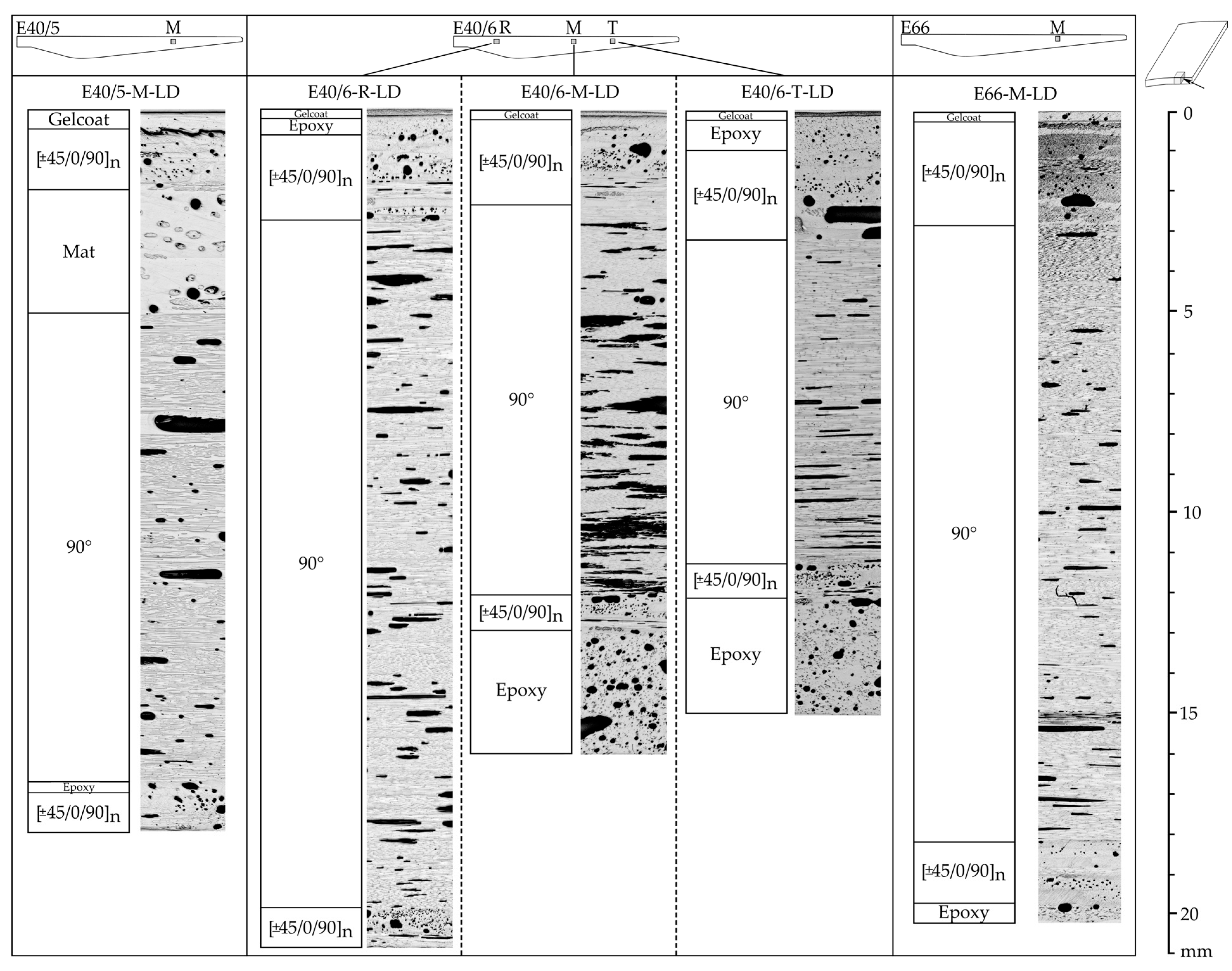
Appendix C. Analytic Prediction
- Geometry and layer set-up (rectangular cross section):
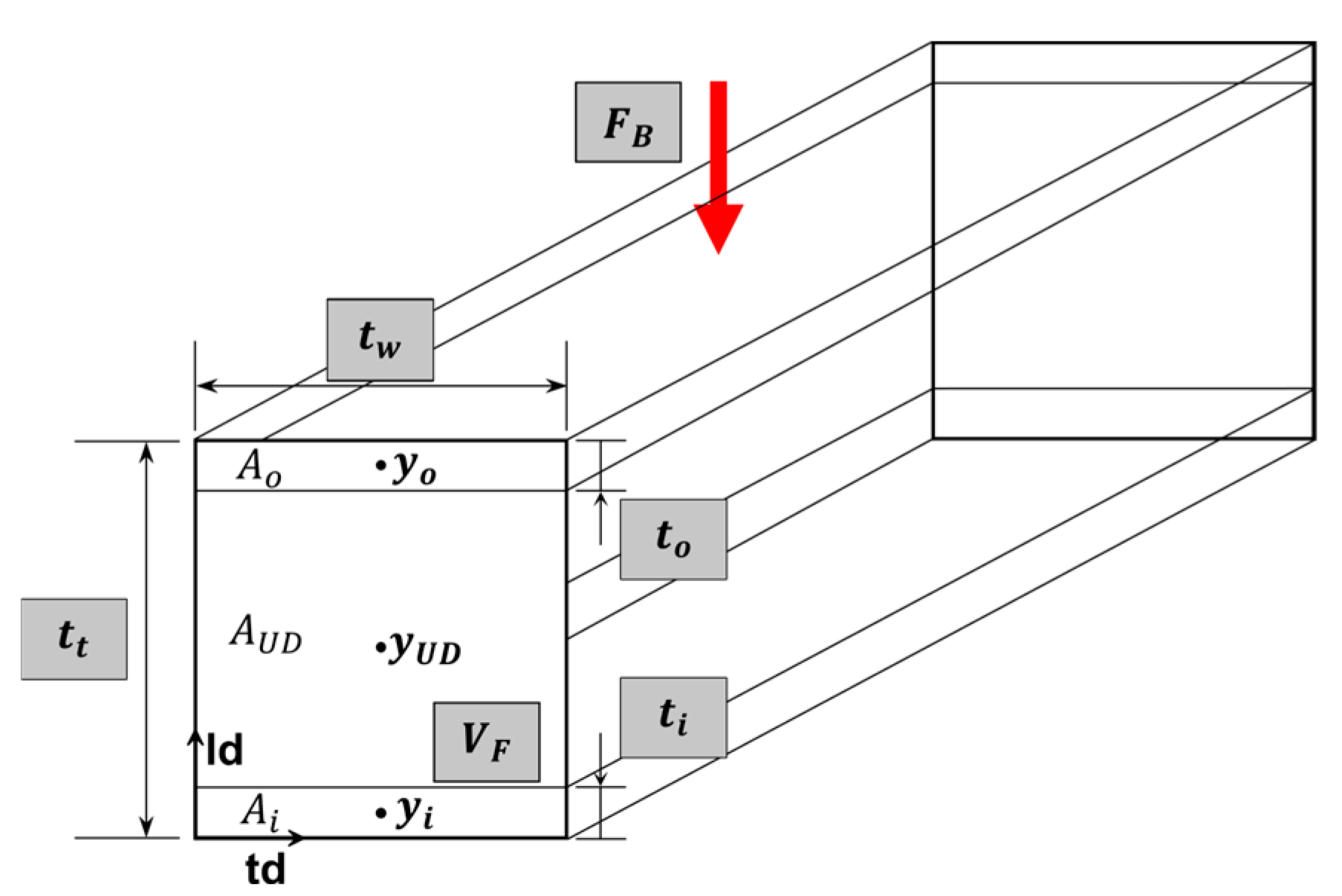
- (1.)
- Homogenised modulus of the UD layer (rule of mixtures)
- (2.)
- E-weighted neutral axis
- (3.)
- E-weighted second moment of area
- (4.)
- Geometric second moment of area of the whole section
- (5.)
- Effective flexural modulus
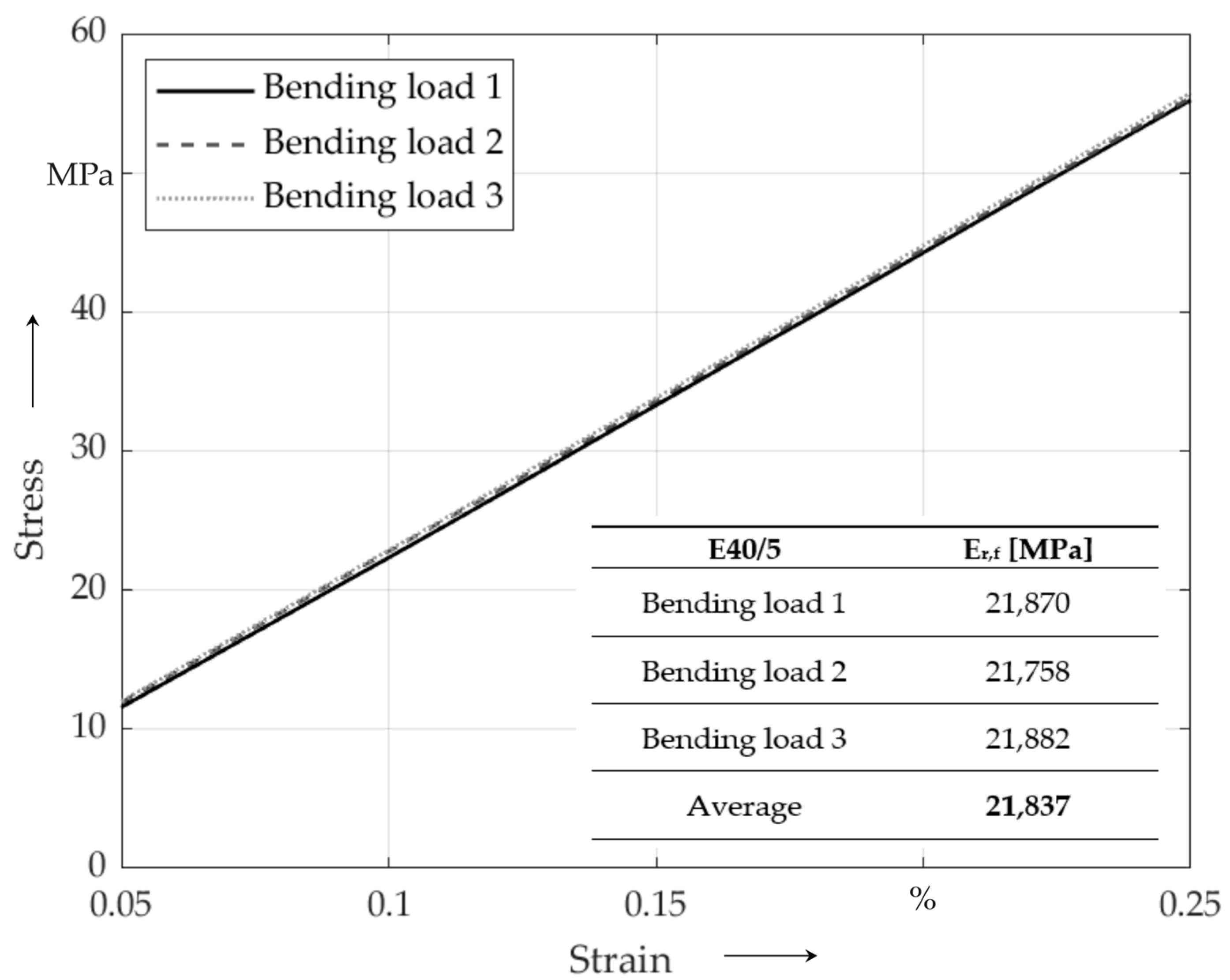
References
- Liu, P.; Barlow, C.Y. Wind turbine blade waste in 2050. Waste Manag. 2017, 62, 229–240. [Google Scholar] [CrossRef] [PubMed]
- Mishnaevsky, L.; Branner, K.; Petersen, H.N.; Beauson, J.; McGugan, M.; Sørensen, B.F. Materials for Wind Turbine Blades: An Overview. Materials 2017, 10, 1285. [Google Scholar] [CrossRef]
- Spini, F.; Bettini, P. End-of-Life wind turbine blades: Review on recycling strategies. Compos. Part B Eng. 2024, 275, 111290. [Google Scholar] [CrossRef]
- Katnam, K.B.; Comer, A.J.; Roy, D.; Da Silva, L.F.M.; Young, T.M. Composite Repair in Wind Turbine Blades: An Overview. J. Adhes. 2015, 91, 113–139. [Google Scholar] [CrossRef]
- Overcash, M.; Twomey, J.; Asmatulu, E.; Vozzola, E.; Griffing, E. Thermoset composite recycling—Driving forces, development, and evolution of new opportunities. J. Compos. Mater. 2018, 52, 1033–1043. [Google Scholar] [CrossRef]
- Beauson, J.; Brøndsted, P. Wind Turbine Blades: An End of Life Perspective. In MARE-WINT; Ostachowicz, W., McGugan, M., Schröder-Hinrichs, J.-U., Luczak, M., Eds.; Springer International Publishing: Cham, Switzerland, 2016; pp. 421–432. ISBN 978-3-319-39094-9. [Google Scholar]
- Lund, K.W.; Madsen, E.S. State-of-the-art value chain roadmap for sustainable end-of-life wind turbine blades. Renew. Sustain. Energy Rev. 2024, 192, 114234. [Google Scholar] [CrossRef]
- Mamanpush, S.H.; Li, H.; Englund, K.; Tabatabaei, A.T. Recycled wind turbine blades as a feedstock for second generation composites. Waste Manag. 2018, 76, 708–714. [Google Scholar] [CrossRef]
- Germanischer Lloyd. Rules and Guidelines Industrial Services: Guideline for the Certification of Offshore Wind Turbines; Germanischer Lloyd: Hamburg, Germany, 2010. [Google Scholar]
- Lahuerta, F.; Gesto, D.; Prieto, C.; Johst, P.; Kucher, M.; Mozas, E.; Gracia, O.; Böhm, R.; Bielsa, J.M. Decommissioning Inventory for Wind Turbine Blades Installed Until 2022 in Europe. Mater. Circ. Econ. 2023, 5, 16. [Google Scholar] [CrossRef]
- Potting, J.; Hekkert, M.; Worrell, E.; and Hanemaaijer, A. Circular Economy: Measuring Innovation in the Product Chain. Available online: https://www.pbl.nl/sites/default/files/downloads/pbl-2016-circular-economy-measuring-innovation-in-product-chains-2544.pdf (accessed on 25 January 2023).
- Kupfer, R.; Schilling, L.; Spitzer, S.; Zichner, M.; Gude, M. Neutral lightweight engineering: A holistic approach towards sustainability driven engineering. Discov. Sustain. 2022, 3, 17. [Google Scholar] [CrossRef]
- Deeney, P.; Nagle, A.J.; Gough, F.; Lemmertz, H.; Delaney, E.L.; McKinley, J.M.; Graham, C.; Leahy, P.G.; Dunphy, N.P.; Mullally, G. End-of-Life alternatives for wind turbine blades: Sustainability Indices based on the UN sustainable development goals. Resour. Conserv. Recycl. 2021, 171, 105642. [Google Scholar] [CrossRef]
- Johst, P.; Kucher, M.; Schulz, P.; Knorr, A.; Kupfer, R.; Böhm, R. Identification of circular eco-subsystems for end-of-life aviation composite components based on a systematized R6-strategy. J. Phys. Conf. Ser. 2023, 2526, 12055. [Google Scholar] [CrossRef]
- Joustra, J.; Flipsen, B.; Balkenende, R. Structural reuse of high end composite products: A design case study on wind turbine blades. Resour. Conserv. Recycl. 2021, 167, 105393. [Google Scholar] [CrossRef]
- Ellen MacArthur Foundation. Towards the Circular Economy: Economic and Business Rationale for an Accelerated Transition. Available online: https://emf.thirdlight.com/file/24/xTyQj3oxiYNMO1xTFs9xT5LF3C/Towards%20the%20circular%20economy%20Vol%201%3A%20an%20economic%20and%20business%20rationale%20for%20an%20accelerated%20transition.pdf (accessed on 20 February 2023).
- André, A.; Juntikka, M.; Mattsson, C.; Hammar, T.; Haghani, R. Sustainable repurpose of end-of-life fiber reinforced polymer composites: A new circular pedestrian bridge concept. J. Environ. Manag. 2024, 367, 122015. [Google Scholar] [CrossRef] [PubMed]
- Bank, L.; Arias, F.; Yazdanbakhsh, A.; Gentry, T.; Al-Haddad, T.; Chen, J.-F.; Morrow, R. Concepts for Reusing Composite Materials from Decommissioned Wind Turbine Blades in Affordable Housing. Recycling 2018, 3, 3. [Google Scholar] [CrossRef]
- Alshannaq, A.A.; Respert, J.A.; Henao, Y.; Bank, L.C.; Gentry, T.R. Experimental Testing and Numerical Analysis of a GFRP BladePole Prototype Repurposed from a Decommissioned GE37 Wind Turbine Blade. J. Compos. Constr. 2025, 29, 04024079. [Google Scholar] [CrossRef]
- André, A.; Bru, T.; Abbasi, A.G.; Sinha, S.; Nunes, S.; Juntikka, M.; Kazmierczak, K.; Egilsson, N.Ó.; Frid, G.; Sobczyk, M.; et al. A Holistic and Circular Approach for Managing End-of-Service Wind Turbine Blades. Sustainability 2024, 16, 7858. [Google Scholar] [CrossRef]
- Beauson, J.; Laurent, A.; Rudolph, D.P.; Pagh Jensen, J. The complex end-of-life of wind turbine blades: A review of the European context. Renew. Sustain. Energy Rev. 2022, 155, 111847. [Google Scholar] [CrossRef]
- MaStR. Aktuelle Einheitenübersicht/Current Unit Overview. Available online: https://www.marktstammdatenregister.de/MaStR/Einheit/Einheiten/OeffentlicheEinheitenuebersicht (accessed on 15 May 2025).
- Alshannaq, A.A.; Respert, J.A.; Bank, L.C.; Scott, D.W.; Gentry, T.R. As-Received Physical and Mechanical Properties of the Spar Cap of a GE37 Decommissioned Glass FRP Wind Turbine Blade. J. Mater. Civ. Eng. 2022, 34, 04022266. [Google Scholar] [CrossRef]
- Ruane, K.; Zhang, Z.; Nagle, A.; Huynh, A.; Alshannaq, A.; McDonald, A.; Leahy, P.; Soutsos, M.; McKinley, J.; Gentry, R.; et al. Material and Structural Characterization of a Wind Turbine Blade for Use as a Bridge Girder. Transp. Res. Rec. 2022, 2676, 354–362. [Google Scholar] [CrossRef]
- Joustra, J.; Flipsen, B.; Balkenende, R. Structural reuse of wind turbine blades through segmentation. Compos. Part C Open Access 2021, 5, 100137. [Google Scholar] [CrossRef]
- Ennis, B.L.; Kelley, C.L.; Naughton, B.T. Optimized Carbon Fiber Composites in Wind Turbine Blade Design. SANDIA REPORT SAND2019-14173. 2019. Available online: https://www.energy.gov/sites/prod/files/2019/12/f69/SAND2019-14173-Optimized.pdf (accessed on 10 June 2025).
- Ackermann, G.; Deußer, S.; Gabler, S.; Gastmeyer, R.; Genzel, E.; Gerold, M.; Jung, C.; Knippers, J.; Krahwinkel, M.; Kruppe, J.; et al. BÜV-Empfehlung: Tragende Kunststoffbauteile im Bauwesen [TKB]: Entwurf, Bemessung und Konstruktion. Available online: https://new.bauueberwachungsverein.de/themes/buev/assets/files/Kunststoff_Empf.pdf (accessed on 10 June 2025).
- Jensen, J.P.; Skelton, K. Wind turbine blade recycling: Experiences, challenges and possibilities in a circular economy. Renew. Sustain. Energy Rev. 2018, 97, 165–176. [Google Scholar] [CrossRef]
- Johst, P.; Bühl, M.; Enderle, C.; Kupfer, R.; Modler, N.; Böhm, R. Forecasting wind turbine blade waste with material composition and geographical distribution: Methodology and application to Germany. Resour. Conserv. Recycl. 2024, 211, 107876. [Google Scholar] [CrossRef]
- Rahimizadeh, A.; Kalman, J.; Fayazbakhsh, K.; Lessard, L. Mechanical and thermal study of 3D printing composite filaments from wind turbine waste. Polym. Compos. 2021, 42, 2305–2316. [Google Scholar] [CrossRef]
- Zhang, Y.; Cui, S.; Wang, X.; Yang, B.; Zhang, N.; Liu, T. Microstructure and performance of recycled wind turbine blade based 3D printed concrete. Clean. Waste Syst. 2025, 10, 100206. [Google Scholar] [CrossRef]
- Carrete, I.A.; Joustra, J.J.; Balkenende, A.R. Circular applications through selection strategies (CATSS): A methodology for identifying reuse applications for end-of-life wind turbine blades. IOP Conf. Ser. Mater. Sci. Eng. 2023, 1293, 12011. [Google Scholar] [CrossRef]
- DIN EN ISO 1172; Textile-Glass-Reinforced Plastics—Prepregs, Moulding Compounds and Laminates—Determination of the Textile-Glass and Mineral-Filler Content Using Calcination Methods. Deutsches Institut für Normung e. V.: Berlin, Germany, 2023.
- DIN EN ISO 1183-1; Plastics-Methods for Determining the Density of Non-Cellular Plastics—Part 1: Immersion Method, Liquid Pycnometer Method and Titration Method. Deutsches Institut für Normung e. V.: Berlin, Germany, 2019.
- Specification—Technical Data and Equipment List: Enercon E-40/6.44/E2/E40-6. Available online: https://en.wind-turbine.com/cms/storage/uploads/2022/08/09/01_specificationenercone40644e244884_uid_62f18c8a4d259.pdf (accessed on 25 April 2025).
- DIN EN ISO 527-5; Plastics—Determination of Tensile Properties—Part 5: Test Conditions for Unidirectional Fibre-Reinforced Plastic Composites. Deutsches Institut für Normung e. V.: Berlin, Germany, 2022.
- DIN EN ISO 11357-1; Plastics—Differentail Scanning Calorimetry (DSC)—Part 1: General Principles. Deutsches Institut für Normung e. V.: Berlin, Germany, 2023.
- DIN EN ISO 14125; Fibre-Reinforced Plastic Composites—Determination of Flexural Properties. Deutsches Institut für Normung e. V.: Berlin, Germany, 2011.
- Rubiella, C.; Hessabi, C.A.; Fallah, A.S. State of the art in fatigue modelling of composite wind turbine blades. Int. J. Fatigue 2018, 117, 230–245. [Google Scholar] [CrossRef]
- Schürmann, H. Konstruieren mit Faser-Kunststoff-Verbunden: Mit 39 Tabellen; 2., bearb. und erw. Aufl.; Springer: Berlin/Heidelberg, Germany, 2007; ISBN 978-3-540-72189-5. [Google Scholar]
- Sayer, F.; Bürkner, F.; Buchholz, B.; Strobel, M.; van Wingerde, A.M.; Busmann, H.-G.; Seifert, H. Influence of a wind turbine service life on the mechanical properties of the material and the blade. Wind Energy 2013, 16, 163–174. [Google Scholar] [CrossRef]
- Ahmed, M.M.Z.; Alzahrani, B.; Jouini, N.; Hessien, M.M.; Ataya, S. The Role of Orientation and Temperature on the Mechanical Properties of a 20 Years Old Wind Turbine Blade GFR Composite. Polymers 2021, 13, 1144. [Google Scholar] [CrossRef] [PubMed]
- DIN EN 1991-1-5; Eurocode 1: Einwirkungen auf Tragwerke—Teil 1-5: Allgemeine Einwirkungen—Temperatureinwirkungen; Deutsche Fassung. Deutsches Institut für Normung e. V.: Berlin, Germany, 2010.

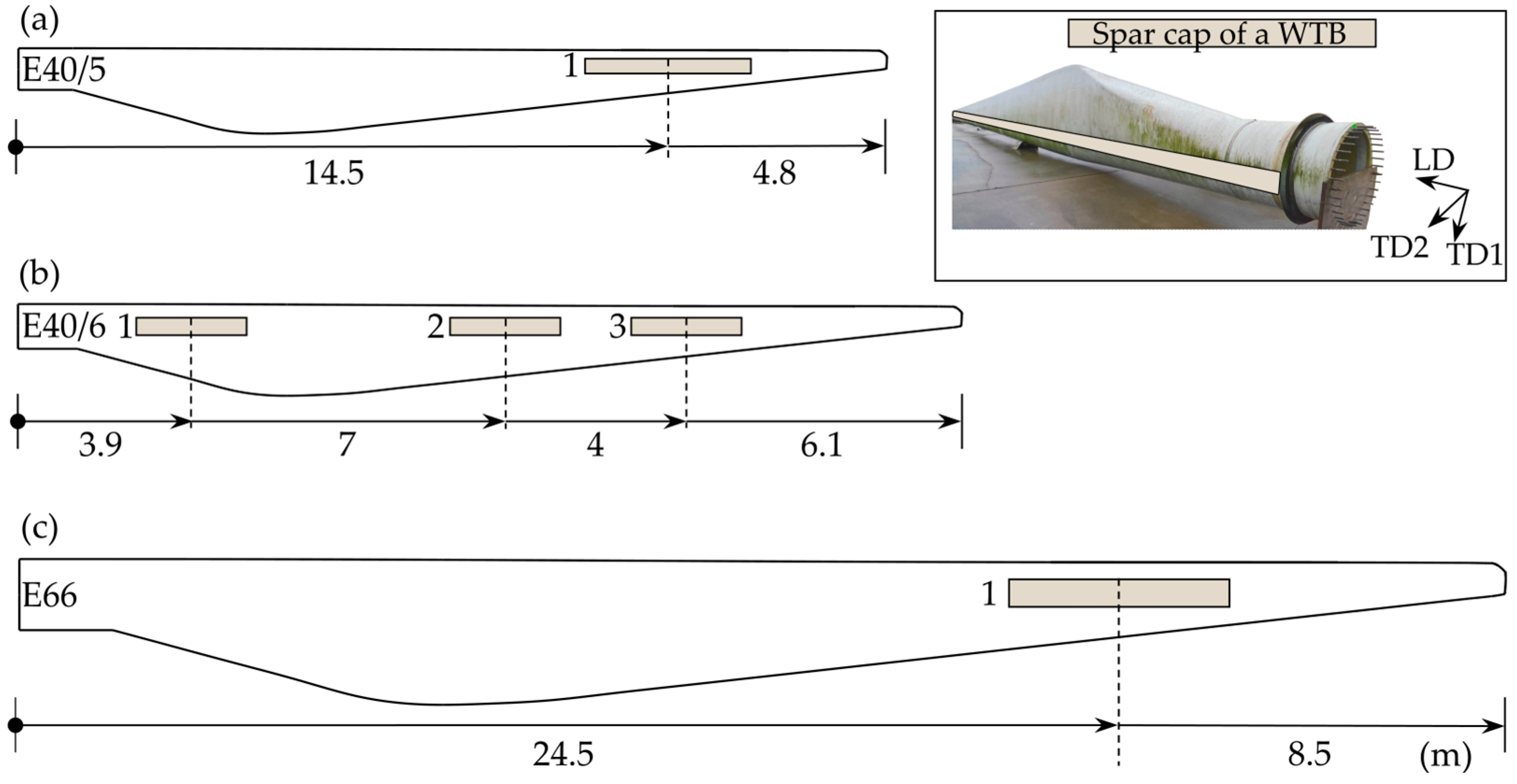
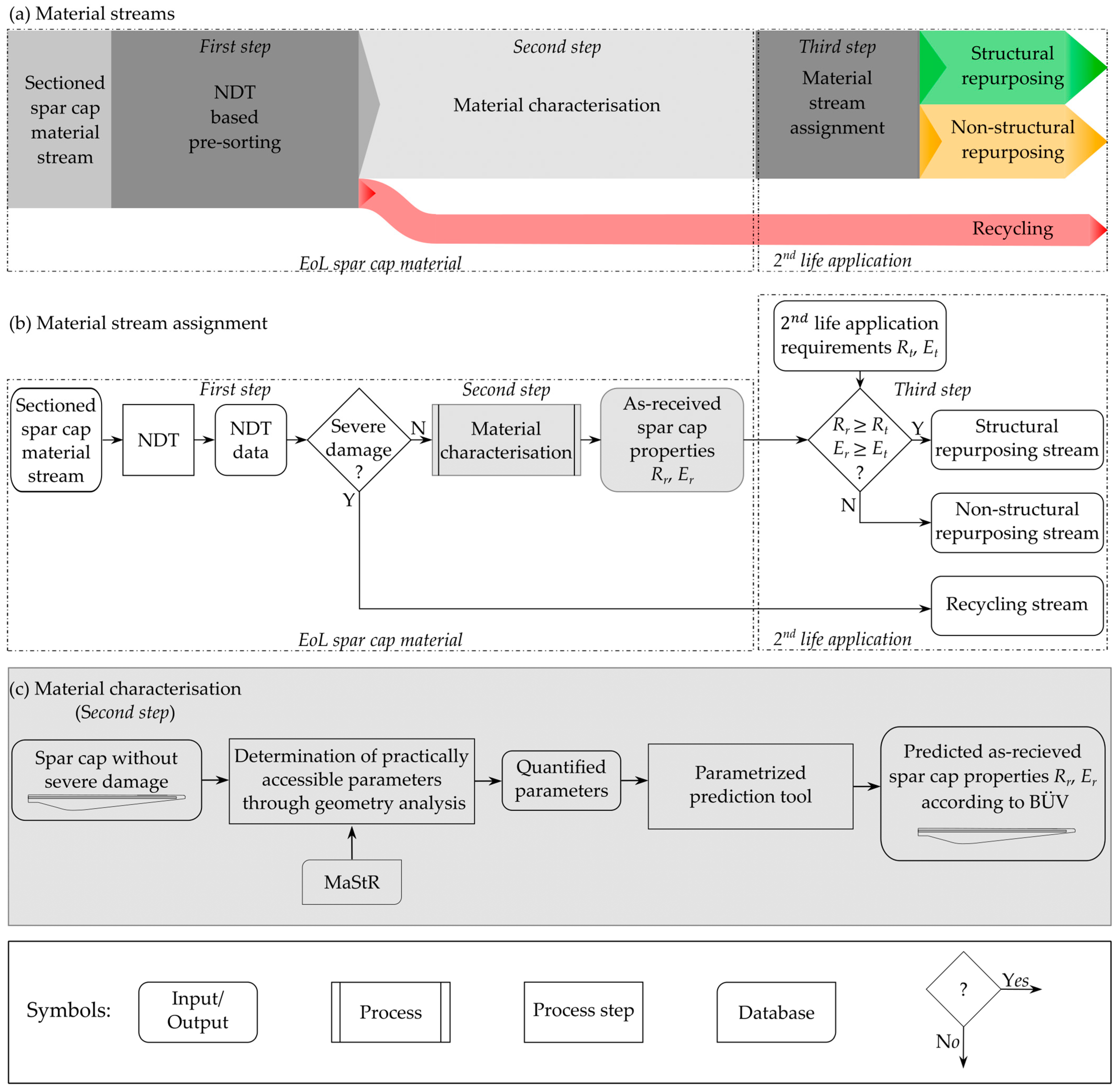

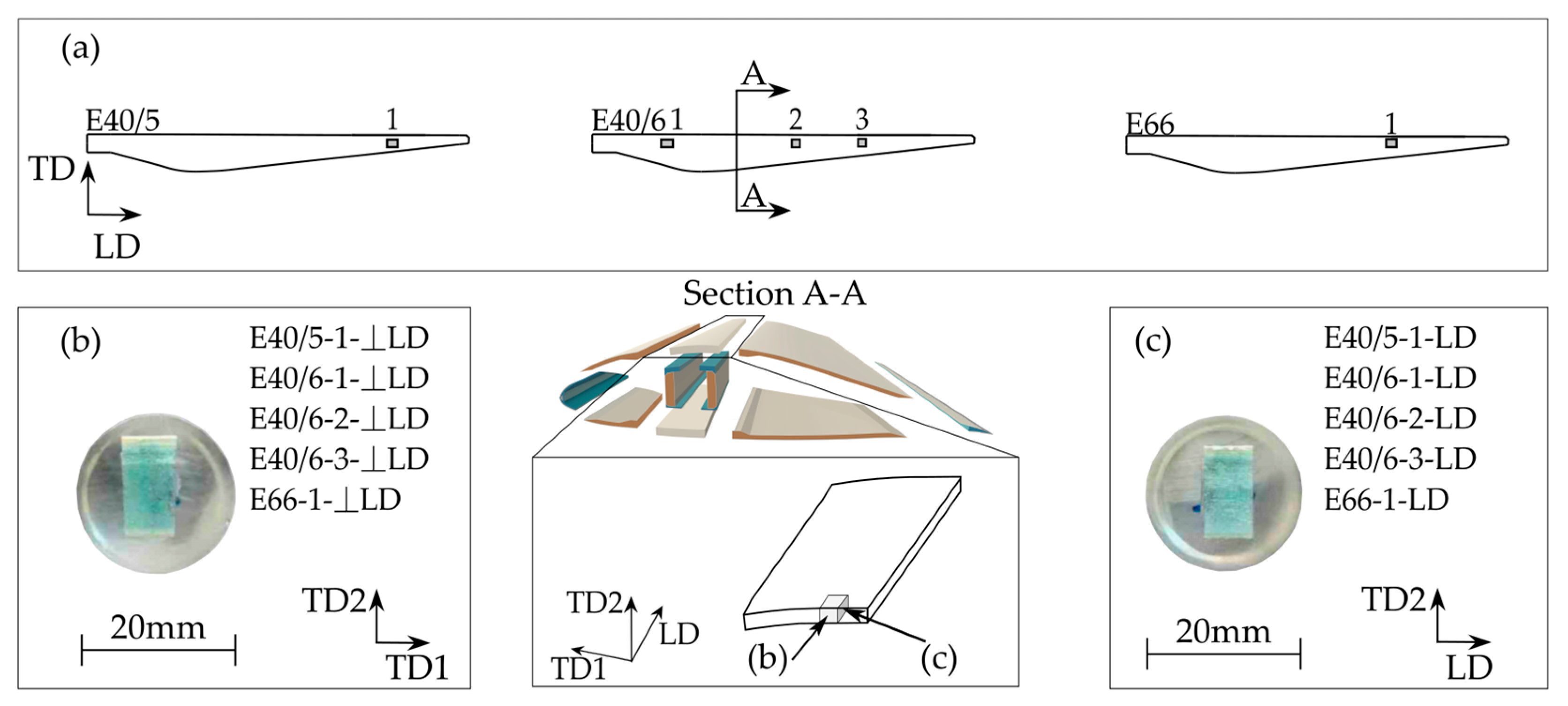
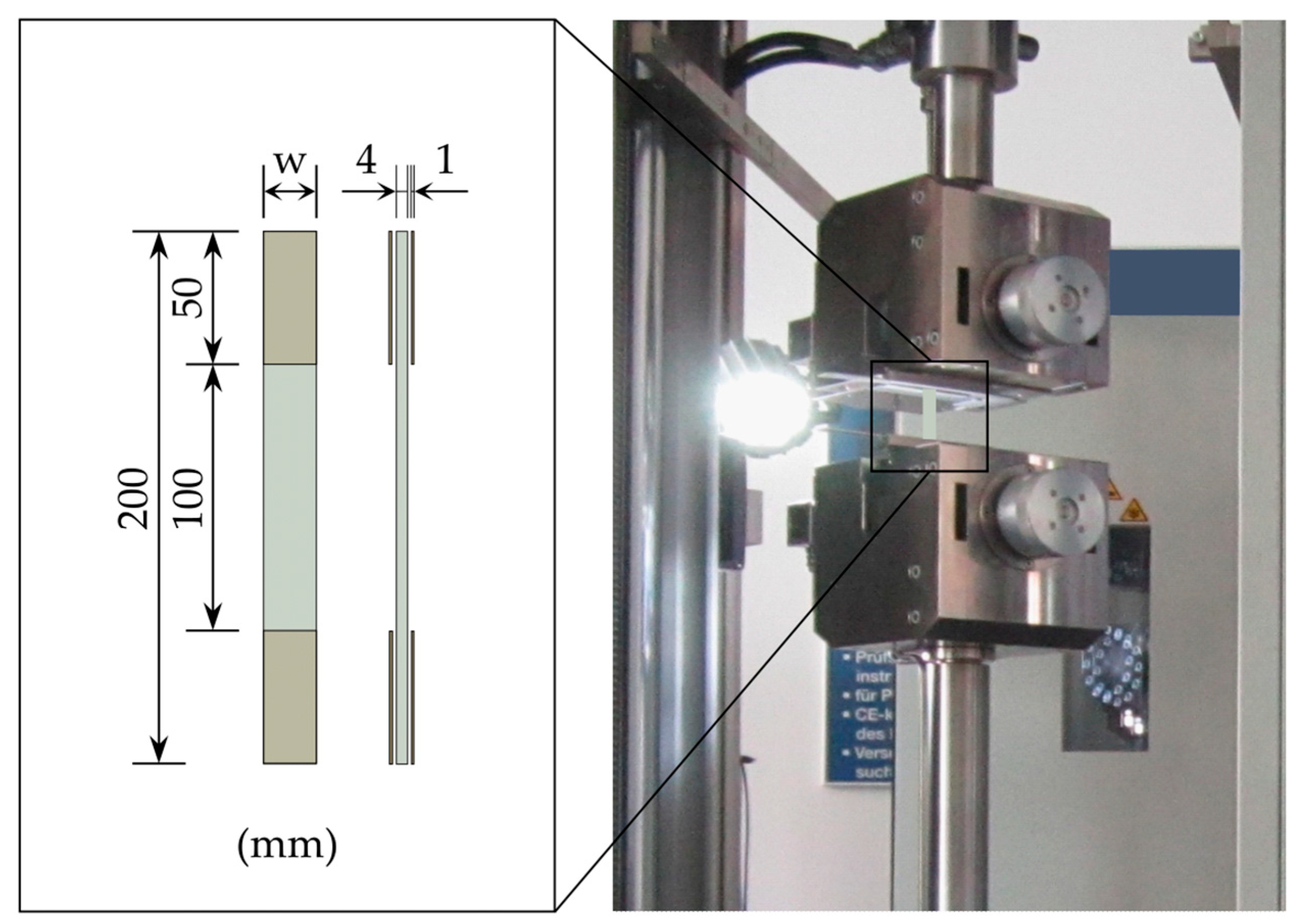
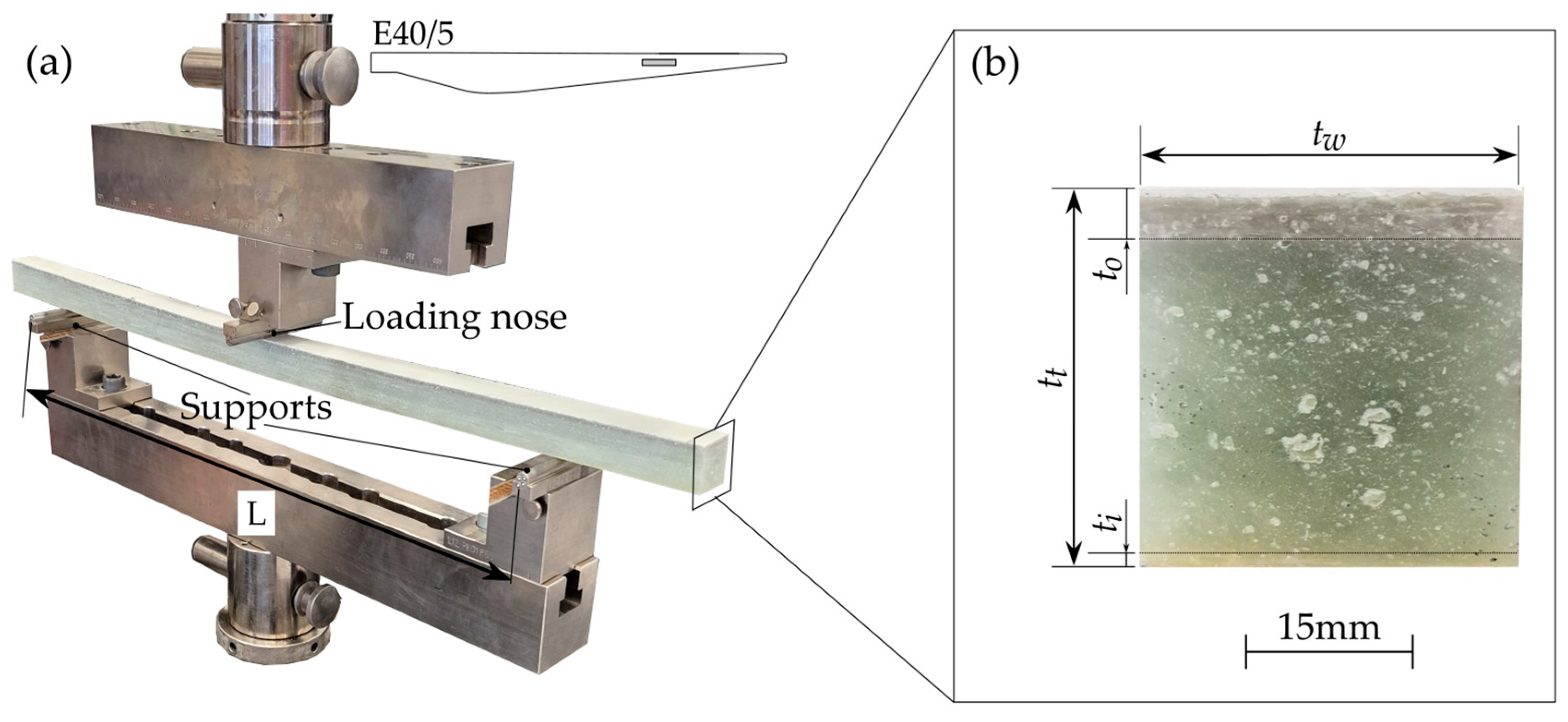


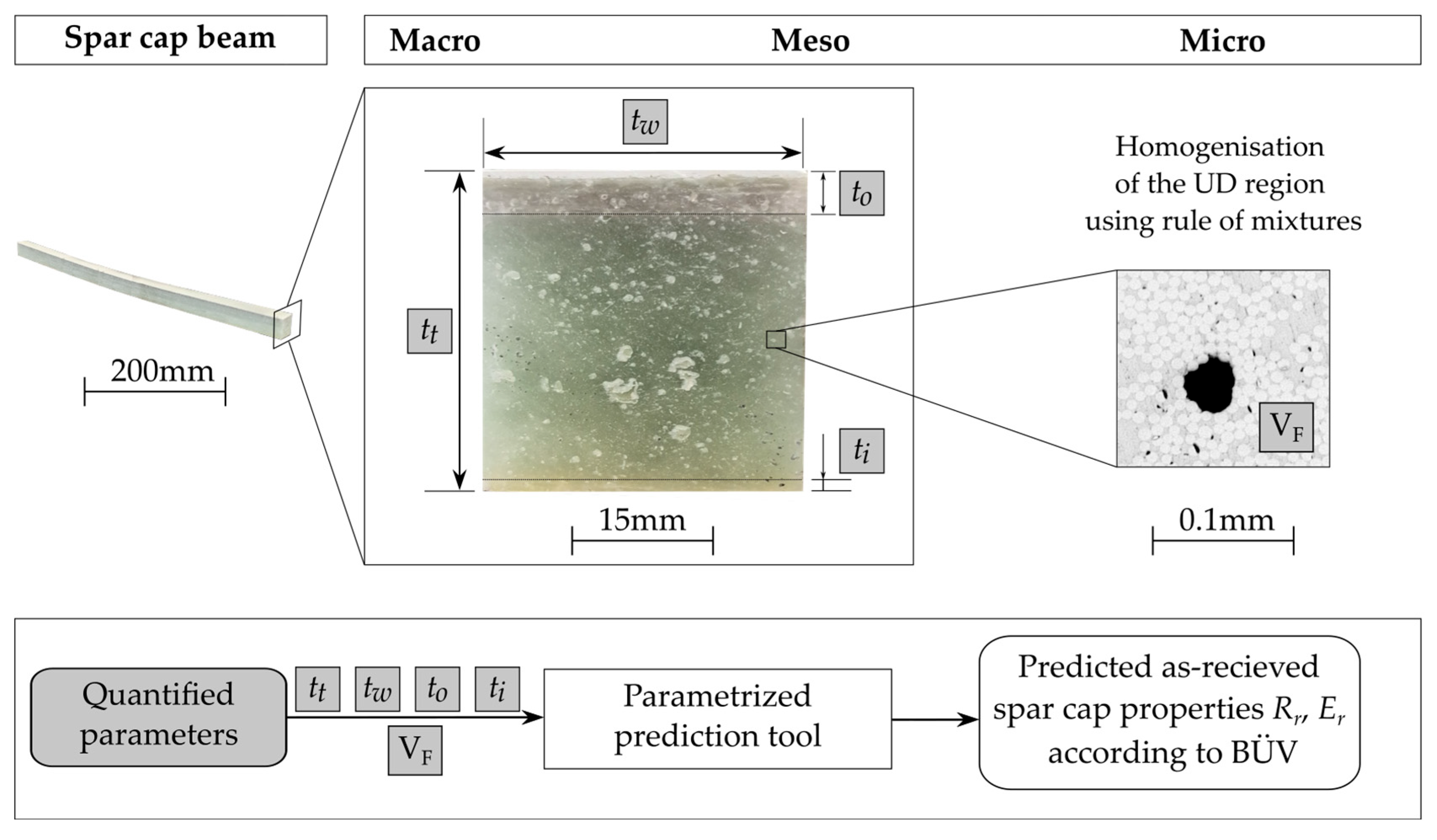
| Location | Spar Cap Thickness | Multiaxial Thickness | Epo/Mat/Gel Thickness | ||
|---|---|---|---|---|---|
| % | mm | mm (%) | mm (%) | mm (%) | |
| E40/5 WTB | |||||
 | 6.9 | 17.2 | 10.3 (60%) | 2.8 (16%) | 4.1 (24%) |
| E40/6 WTB | |||||
 | 6.8 | 20.8 | 17.8 (86%) | 2.3 (11%) | 0.7 (3%) |
 | 7.5 | 16.0 | 10.7 (67%) | 3.1 (19%) | 2.2 (14%) |
 | 12.0 | 14.6 | 7.8 (53%) | 3.7 (26%) | 3.1 (21%) |
| E66 WTB | |||||
 | 4.8 | 20.4 | 15.4 (75%) | 4.2 (21%) | 0.8 (4%) |
| Location | N | Mm (%) | MF (%) | Vm (%) | VF (%)/COV |
|---|---|---|---|---|---|
| E40/5 WTB | |||||
 | 5 | 35.0 | 65.0 | 49.3 | 43.9/4.33 |
| E40/6 WTB | |||||
 | 6 | 26.6 | 73.4 | 41.3 | 54.7/3.11 |
 | 4 | 25.4 | 74.6 | 40.3 | 56.6/3.0 |
 | 4 | 24.2 | 75.8 | 38.3 | 57.6/1.91 |
| Average | 25.4 | 74.6 | 40.0 | 56.3/2.67 | |
| E66 WTB | |||||
 | 5 | 27.6 | 72.4 | 43.0 | 54.2/0.92 |
| Location | Direction | N * | ||||||
|---|---|---|---|---|---|---|---|---|
| Mean (MPa) | COV * | Mean (GPa) | COV * | Mean (%) | COV * | |||
| E40/5 WTB | ||||||||
 | LD | 24 | 478.49 | 8.43 | 30.71 | 7.9 | 1.70 | 11.59 |
| TD | 16 | 17.39 | 12.88 | 6.92 | 9.22 | 0.24 | 10.34 | |
| E40/6 WTB | ||||||||
 | LD | 5 | 496.9 | 11.72 | 38.56 | 2.13 | 1.43 | 12.82 |
| TD | 8 | 14.70 | 14.32 | 8.25 | 10.39 | 0.17 | 12.05 | |
 | LD | 7 | 566.61 | 4.96 | 40.32 | 1.58 | 1.5 | 5.52 |
 | TD | 14 | 16.77 | 11.18 | 12.31 | 7.65 | 0.13 | 13.66 |
| E66 WTB | ||||||||
 | LD | 15 | 698.78 | 9.96 | 37.45 | 2.64 | 2.07 | 11.4 |
| TD | 9 | 34.47 | 5.75 | 10.34 | 2.06 | 0.34 | 9.06 | |
| WTB Model/ Length | History | VF (%) | (MPa) | (GPa) | (%) | |||||
|---|---|---|---|---|---|---|---|---|---|---|
| Void Density | Service Life (Years) | |||||||||
| This study | E40/5/ 19.3 m | High | 20 | 43.9 * | 478.49 | 17.63 | 30.71 | 6.87 | 1.7 | 0.25 |
| E40/6/ 21 m | High | 0 | 56.3 * | 531.76 | 16.01 | 39.44 | 10.83 | 1.47 | 0.14 | |
| E66/ 33 m | Low | 20 | 54.2 * | 698.78 | 34.47 | 37.45 | 10.34 | 2.07 | 0.34 | |
| Data in the literature | GE 37/ 37 mm [23] | Assumed to be low | 11 | 48–50 | 597 | 33.6 | 36.8 | 10.7 | 1.94 | 0.29 |
| DEBRA-25/ 11.6 m [41] | Not specified | 18 | - | 470.1 | - | 25.97 | - | 1.87 | - | |
| 100 kW WT/ 9.8 m [42] | High | 20 (unidentified) | 38–40 ** | 350 | 70 | 15.6 | 7.4 | 1.75 | 0.95 | |
| LM 13.4/ 13.4 m [24] | Not specified | 27 | 36–43 | 342 | 16 | 27.5 | - | - | - | |
| Scale | Parameter |
|---|---|
| Macro/Meso | as overall spar cap thickness as overall spar cap width as outer non-UD region thickness as inner non-UD region thickness |
| Micro | representing the fibre volume fraction of the UD region |
Disclaimer/Publisher’s Note: The statements, opinions and data contained in all publications are solely those of the individual author(s) and contributor(s) and not of MDPI and/or the editor(s). MDPI and/or the editor(s) disclaim responsibility for any injury to people or property resulting from any ideas, methods, instructions or products referred to in the content. |
© 2025 by the authors. Licensee MDPI, Basel, Switzerland. This article is an open access article distributed under the terms and conditions of the Creative Commons Attribution (CC BY) license (https://creativecommons.org/licenses/by/4.0/).
Share and Cite
Johst, P.; Bühl, M.; André, A.; Kupfer, R.; Protz, R.; Modler, N.; Böhm, R. Characterisation of End-of-Life Wind Turbine Blade Components for Structural Repurposing: Experimental and Analytic Prediction Approach. Sustainability 2025, 17, 7783. https://doi.org/10.3390/su17177783
Johst P, Bühl M, André A, Kupfer R, Protz R, Modler N, Böhm R. Characterisation of End-of-Life Wind Turbine Blade Components for Structural Repurposing: Experimental and Analytic Prediction Approach. Sustainability. 2025; 17(17):7783. https://doi.org/10.3390/su17177783
Chicago/Turabian StyleJohst, Philipp, Moritz Bühl, Alann André, Robert Kupfer, Richard Protz, Niels Modler, and Robert Böhm. 2025. "Characterisation of End-of-Life Wind Turbine Blade Components for Structural Repurposing: Experimental and Analytic Prediction Approach" Sustainability 17, no. 17: 7783. https://doi.org/10.3390/su17177783
APA StyleJohst, P., Bühl, M., André, A., Kupfer, R., Protz, R., Modler, N., & Böhm, R. (2025). Characterisation of End-of-Life Wind Turbine Blade Components for Structural Repurposing: Experimental and Analytic Prediction Approach. Sustainability, 17(17), 7783. https://doi.org/10.3390/su17177783









